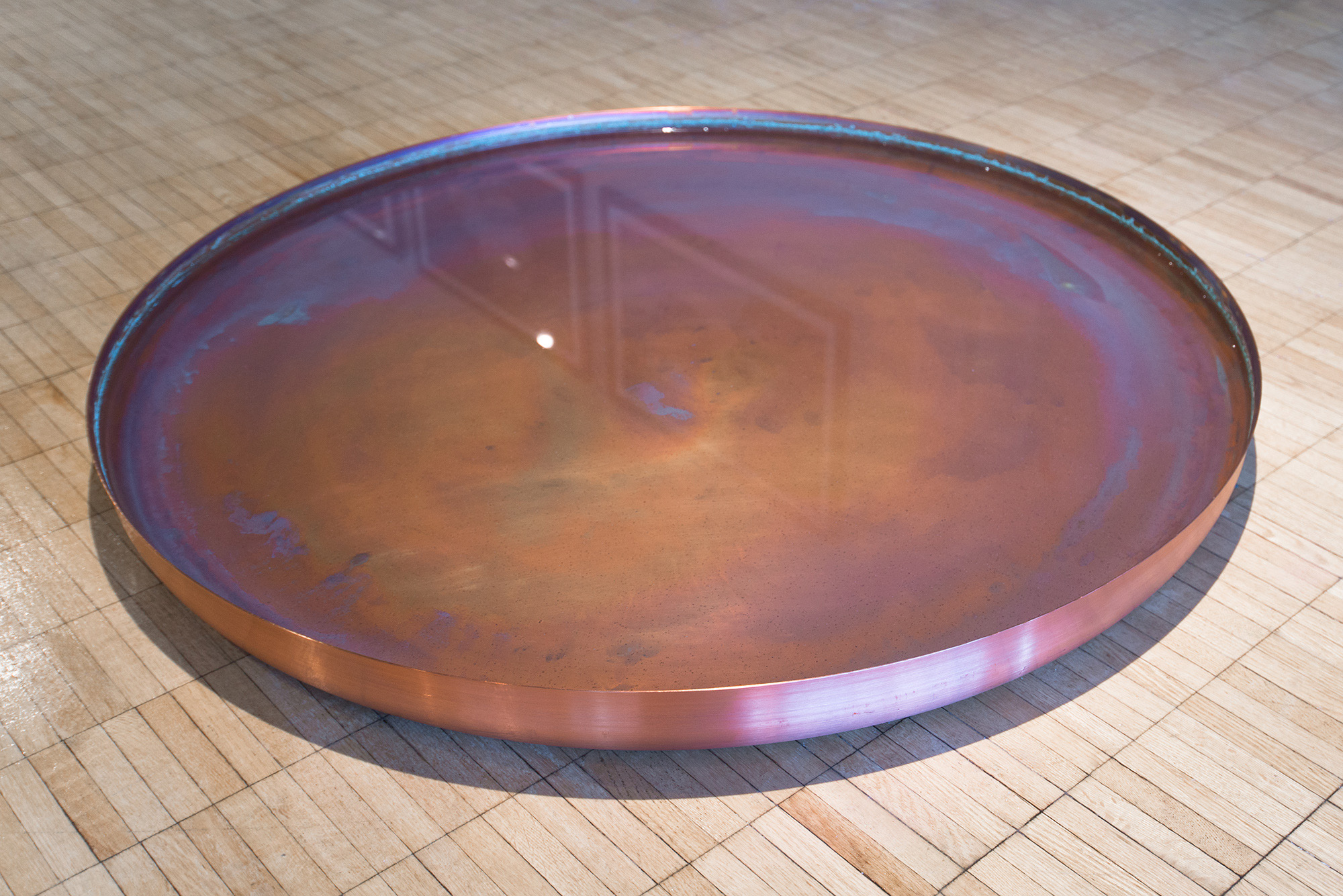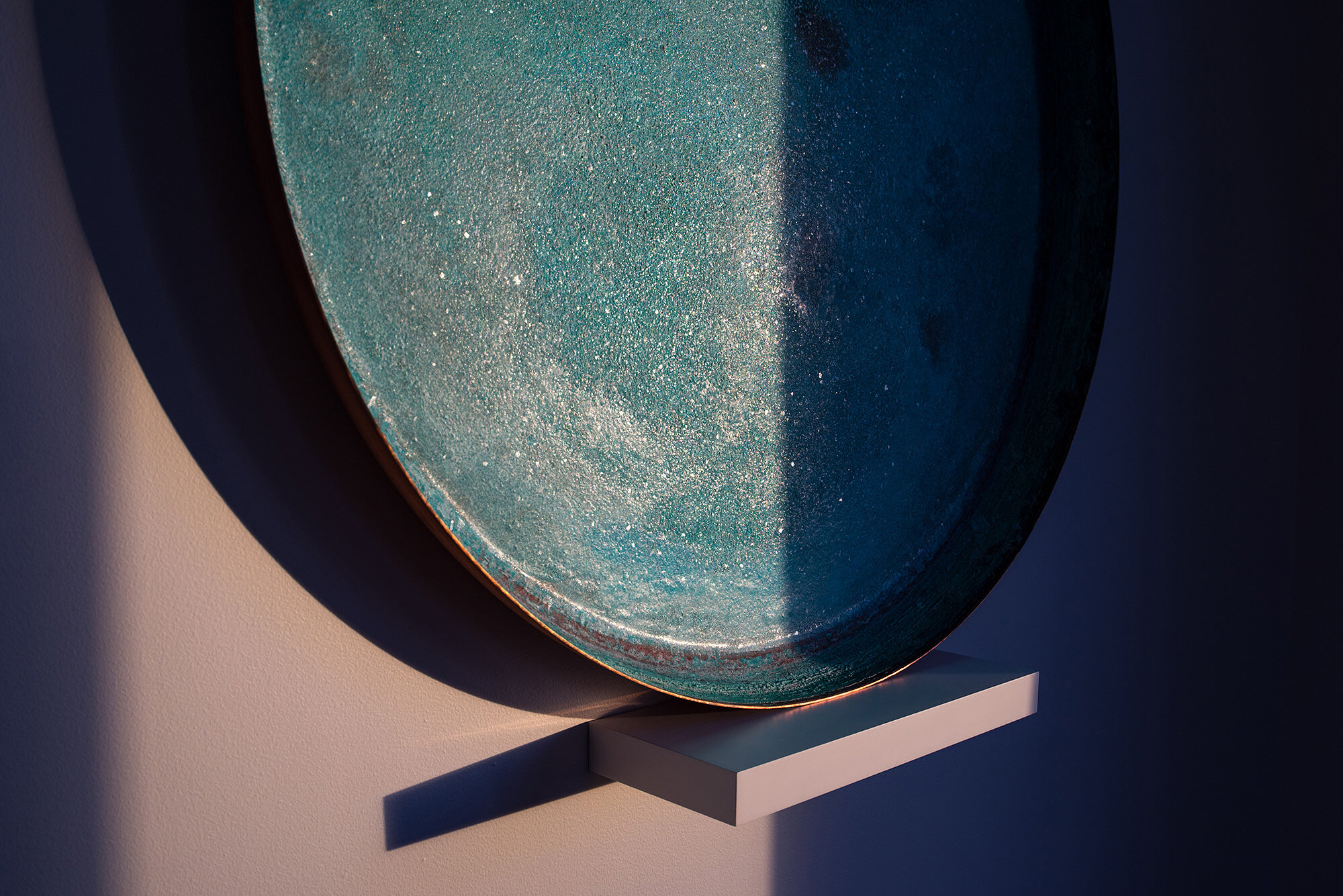DESERT POOLS (ATACAMA)
Harbourfront Centre Gallery, Toronto, Canada
Recipient of DesignTO Award – Best in Festival: New Work
Curated by Deborah Wang and Robyn Wilcox for DesignTO’s thematic exhibition Surface Tension
Interview by DesignTO for 2019 Best in Festival: New Work Award
Commissioned by DesignTO
Supported by the Ontario Arts Council
La Wayaka Current Artist in Residence DESERT 23°S
Hand spun copper, water, natural solar salt from the Salar de Atacama, Atacama Desert, Chile
2019
“Fish, amphibian, and reptile, warm-blooded bird and mammal—each of us carries in our veins a salty stream in which the elements sodium, potassium, and calcium are combined in almost the same proportions as in sea water. This is our inheritance from the day, untold millions of years ago, when a remote ancestor, having progressed from the one-celled to the many-celled stage, first developed a circulatory system in which the fluid was merely the water of the sea. ”
Desert Pools (Atacama) is a series of eight reflecting pools referencing the lagunas of the Salar de Atacama in the Atacama Desert of northern Chile. The installation is the culmination of a research-based artist residency in the Atacama Desert undertaken at the end of 2018 with La Wayaka Current. Each hand spun copper form was filled with a solution of natural, mineral-rich solar salt crystals ethically collected from the salt lake bed in the center of the Atacama Desert. Over the course of the exhibition, vibrant mineral “ecologies” evolved in the evaporating pools through the processes of oxidation and crystallization activated by water. The dynamic saltwater pools evoke the elemental conditions that characterize the otherworldly waterbodies and volcanic landscapes of the Atacama Desert. At the conclusion of the exhibition, most of the water had evaporated, revealing a natural verdigris patina and crystallized landscape inside each sculpture.
In the Atacama Desert, the process of evaporation has greatly exceeded precipitation for millions of years. This virtually rainless plateau is considered to be the oldest and driest desert on Earth, estimated to have evolved over 150 million years of aridity (1) and 10 to 15 million years of hyper-aridity (2). At its nucleus is a vast pre-Andean depression encircled by impressive salt formations and a Martian terrain. Here, primordial waters of volcanic origin and Andean snowmelt navigate in subterranean waterbeds to the Salar de Atacama, a vast salt lake that emerges as a series of ephemeral pools and lagunas. Composed of purple and red-coloured ancient microorganisms, these geobiological aquatic ecosystems are vital refugia for a diversity of bird life including three species of flamingo listed on the International Union for Conservation of Nature (IUCN) Red List of Threatened Species: Andean Flamingo, Chilean Flamingo and James’s Flamingo.
For generations, these saltwater pools have been visited as sacred places of medicinal and spiritual healing by the region’s Likan Antai Indigenous communities. Historically, each January, in summer, much of the water evaporates exposing the lakebed’s immense crystalline shroud of salt.
Following more than six weeks in the Atacama Desert, Abel’s atmospheric installation is a quiet contemplation about both the conspicuous presence and stark absence of water in the magnificent and challenging temper of the Atacama. In the immediacy of the desert, one is reminded that we are made of water, and much of living relates to replenishing our physical and psychological geographies with this extraordinary substance. The work invites meditation on water’s transience and transformation, with reflection on how these fundamental processes are mirrored in the lifespan of one’s own being. Like the “water mirrors”—circular water-filled vessels—used as reflecting pools by ancient astronomers to observe and interpret the constellations, Desert Pools (Atacama) considers an aquatic cosmovision across deep time. Whether body or landscape, everything is interconnected by the dynamism of water and always has been.
The cyclical equilibrium of the Atacama Desert, which has remained relatively undisturbed for millennia, is increasingly altered by the effects of large-scale patterns of human consumption, contamination and destruction. In recent years (including January 2019 when this work was exhibited) unprecedented rains associated with the “altiplanic winter” between December and March, which brings moist air over the Andes Mountains, channeled torrents of water into the desert, decimating wildlife habitat and causing flooding devastation in towns and villages. The occurrence of these major rain events is attributed to changing conditions over the Pacific Ocean as a result of climate change. Although climate models suggest that such rain events could occur in the desert once every century, there are no records of extreme precipitation events in the core of the desert for the past 500 years (3). Combined with the impacts of climate change are the global demands on northern Chile’s distinct geodiversity, which has led to an expansion of lithium mining operations that drain and contaminate water sources, along with extraction of boron and copper, including the world’s largest copper mine.
A local movement to protect the intrinsic ecological and cultural significance of the lagunas and associated ecosystems of the Salar de Atacama, particularly from lithium mining, has led to creation of a series of nature reserves under the care and governance of the Indigenous communities of the region. Desert Pools (Atacama) is inspired by, and dedicated to, this grassroots environmental movement.
VERTICAL REPRISE
Exactly one year later in 2020, the copper sculptures of Desert Pools (Atacama) were installed in a vertical reprise illuminated by the low winter sun of the Northern Hemisphere.
In the spirit of geoheritage, copper is an integral part of this work as an acknowledgement of the mineral's geological significance in northern Chile and its traditional and contemporary role in Chilean design and craft.
The natural solar salt utilized in this work was sourced by purchasing it from a locally owned shop in San Pedro de Atacama in support of the town’s economy. This small business harvests small amounts of salt and herbs from the desert for food consumption.
Intro. Carson, Rachel. The Sea Around Us. Oxford University Press, 1951, p. 13.
1. Hartley, Adrian J. et al. "150 million years of climatic stability: Evidence from the Atacama Desert, Northern Chile." Journal of the Geological Society, 162(3), 2005, pp. 421-424.
2. Gómez-Silva, Benito et al. "Atacama Desert Soil Microbiology." Microbiology of Extreme Soils, vol. 13, Springer, Berlin, Heidelberg, 2008, pp. 117-132.
3. Azua-Bustos, Armando et al. "Unprecedented rains decimate surface microbial communities in the hyperarid core of the Atacama Desert." Scientific Reports, vol. 8, article 16706, November 2018.
DesignTO and the Ontario Arts Council are gratefully acknowledged for funding this project
















